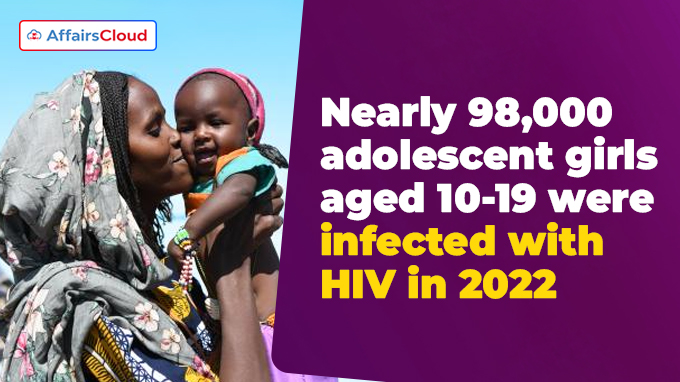 The United Nations Children’s Fund (UNICEF) published the Global Snapshot on HIV and AIDS: Progress and Priorities for Children, Adolescents, and Pregnant Women, which provides global statistical and response updates on children, adolescents, and pregnant women.
The United Nations Children’s Fund (UNICEF) published the Global Snapshot on HIV and AIDS: Progress and Priorities for Children, Adolescents, and Pregnant Women, which provides global statistical and response updates on children, adolescents, and pregnant women.
- As per the publication, nearly 98,000 adolescent girls aged 10-19 were infected with Human Immunodeficiency Virus (HIV) in 2022 – or 1,900 new infections every week, it shows a significant testing and medication access gaps persist among children and adolescents.
- The report was published ahead of World Acquired immunodeficiency syndrome (AIDS) Day 2023 (1 December)
Analysis of the Global Snapshot:
i.The Global Snapshot further highlights how children and young adolescents encounter significant hurdles in accessing HIV treatment.
ii.Globally, almost 1 million people aged 0-19 living with HIV lack treatment.
- Eastern and Southern Africa bear the highest burden (about 60%) for untreated HIV infection among the 0-19 age group, followed by West and Central Africa, East Asia, the Pacific, Latin America, the Caribbean, and South Asia.
Key Facts:
i.In 2022, despite a commendable reduction in HIV infections among girls aged 10-19, challenges persist, especially for adolescent girls.
- Total infections in girls aged 10-19 nearly halved since 2010 (190,000 to 98,000).
- However, girls remain more than twice as likely to contract HIV compared to boys.
ii.Globally, 270,000 new HIV infections occurred among individuals aged 0-19 in 2022.
- The total number of young people living with HIV reached 2.6 million.
iii.In 2022, the number of adolescent girls and young women acquiring HIV was halved (53%) compared to 2010.
Note: Girls face disproportionate challenges in the battle against HIV, rooted in gender inequalities, geographical barriers, and limited access to crucial health programs.
Sub-Saharan Africa- highest rates of HIV risk:
i.In Sub-Saharan Africa, HIV prevalence among girls (10-24 years) is consistently over 3 times higher than among boys.
ii.Sub-Saharan Africa, which is home to approximately 87% of children (0–14 years) and 82% of adolescents (10–19 years) living with HIV.
Diagnostic Hindrances for Children:
i.Cumbersome processes hinder timely diagnoses for children.
- Specific testing requirements for infants are often unavailable in many middle- and lower-income countries.
ii.Only 57% of children aged 0–14 receive Antiretroviral Treatment (ART), in contrast to 77% of those aged 15 and above.
Note: Despite comprising 7% of people living with HIV, children and adolescents (0-19 years) accounted for 15% of AIDS-related deaths in 2022.
Challenges of Pregnant Women:
i.The number of pregnant women living with HIV is 1.2 million and 25% of all pregnant women living with HIV, globally, are aged 15–24 years
ii.Vertical transmission during pregnancy and breastfeeding was significantly reduced but challenges persist with ART coverage stagnating.
- Vertical transmission rates dropped from 23% in 2010 to around 11% in 2022.
iii.Pregnant women with HIV not universally receive antiretroviral (ARV) drugs.
- In 2010, only 48% of pregnant and breastfeeding women living with HIV received ARV drugs and in 2022 this had increased to 82% but progress has stalled.
Other Publications:
Apart from the global snapshot, UNICEF released a set of new publications for World AIDS Day 2023:
1.Regional Snapshots on HIV and AIDS;
- For West and Central Africa, Eastern and Southern Africa.
2.Leveraging the Learning: Insights from HIV programming for pregnant and parenting adolescents;
- It is the first report in the new Leveraging the Learning series.
3.Getting back on track to ending AIDS in Children: It could just be easier than you think.
Recent related News:
The United Nations (UN) report titled, “Progress on the Sustainable Development Goals (SDGs): The Gender Snapshot 2023″ states that the world is failing in its efforts towards achieving SDG 5: gender equality, due to the biases against women around the world in health, education, employment and the halls of power.
About United Nations Children’s Fund (UNICEF):
Executive Director– Catherine M. Russell
Headquarters– New York, United States of America (USA)
Established in– 1946




